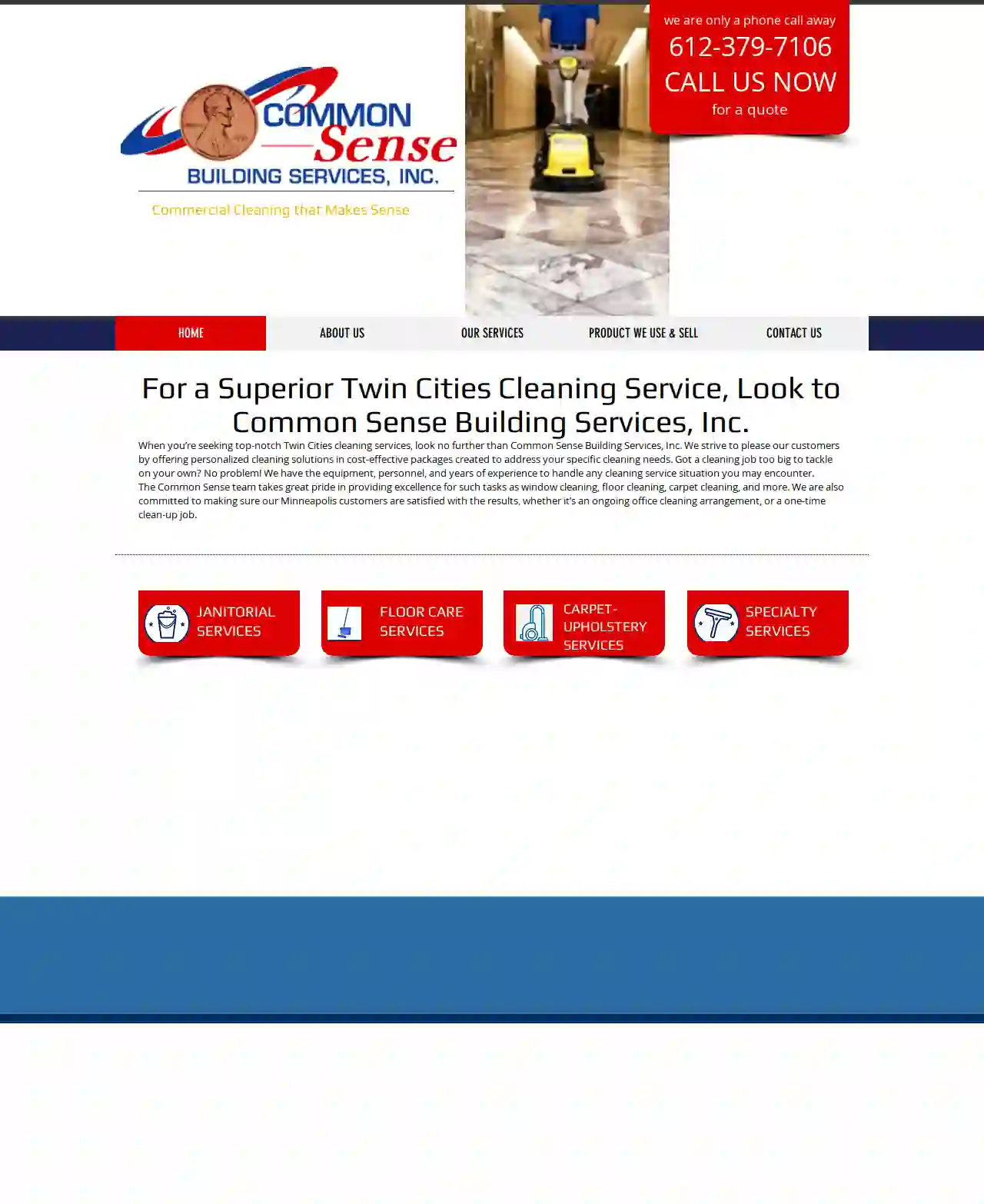Cleaning Services Brainerd
Top 10 Home Cleaning in Brainerd
Get up to 3 Cleaning Companies quotes for your project today! Compare profiles, reviews, accreditations, portfolio, etc... and choose the best offer.
Service Needed
City or Town

Common Sense Building Services
2.812 reviewsMinneapolis, US- Services
- Why Us?
Get Quote
Executive Cleaning Services
54 reviewsRochester, US- Services
- Why Us?
Get Quote
Suite Cleaning Services
55 reviewsMinneapolis, US- Services
- Why Us?
Get Quote
The Red Rose
522 reviewsMinneapolis, US- Services
- Why Us?
Get Quote
Commercial Cleaning Contractors
55 reviewsMinneapolis, US- Services
- Why Us?
Get Quote
Unlimited Cleaning & Projects
51 reviewsMinneapolis, US- Services
- Why Us?
Get Quote
Minnesota Cleaning Solutions, LLC
4.25 reviewsMinneapolis, US- Services
- Why Us?
Get Quote
Total Cleaning Solutions LLC | TCS.
4.817 reviewsMinneapolis, US- Services
- Why Us?
Get Quote- C.
C.G. Professional Services Inc
55 reviewsRochester, US- Services
- Why Us?
Get Quote - Fi
Five Star Cleaning Services of Rochester, LLC
4.685 reviewsRochester, US- Services
- Why Us?
Get Quote
Over 60,241+ Cleaning Services in our network
Our cleaning companies operate in Brainerd and beyond!
CleaningMatch has curated and vetted Top Cleaning Companies near Brainerd. Find the most reliable business today.
Frequently Asked Questions About Cleaning Services
Find answers to common questions about cleaning services and hiring cleaning companies in the USA.
- Frees up your time: Cleaning can be time-consuming, especially for larger properties or busy individuals. Hiring a cleaning service allows you to focus on other priorities, such as work, family, or leisure activities.
- Ensures a deeper clean: Professional cleaners are trained in effective cleaning techniques and have access to specialized equipment, resulting in a more thorough clean than you might achieve on your own.
- Reduces allergens and improves hygiene: Thorough cleaning removes dust, allergens, and germs, creating a healthier living environment, particularly for those with allergies or sensitivities.
- Reduces stress and improves well-being: Coming home to a clean and tidy home can reduce stress and promote a sense of calm and order.
- Cleaning: Removing dirt, dust, and debris from surfaces using soap or detergent and water. It improves the appearance and removes visible contaminants.
- Sanitizing: Reducing the number of bacteria on surfaces to a safe level. It uses chemical disinfectants or heat to kill or inactivate bacteria.
- Disinfecting: Killing or inactivating most disease-causing microorganisms on surfaces. It uses stronger chemical disinfectants than sanitizing and targets a wider range of pathogens.
- Declutter Regularly: Set aside time regularly to declutter your belongings. Donate, sell, or discard items you no longer use or need.
- Designated Storage: Assign specific storage spaces for different items, such as shelves for books, drawers for clothes, and containers for toys.
- Labeling: Label storage containers and drawers to make it easy to find items and put them back in their designated places.
- 'One In, One Out' Rule: For every new item you bring into your home, get rid of an old one. This prevents clutter from accumulating.
- Vertical Storage: Utilize vertical storage solutions, such as shelves, wall organizers, and hanging racks, to maximize space.
- Digital Organization: Organize digital files and emails to reduce paper clutter. Use cloud storage services to free up space on your computer.
- Using the wrong cleaning products: Certain cleaning products are unsuitable for specific surfaces. Using abrasive cleaners on delicate surfaces can cause scratches or discoloration.
- Not reading product instructions: Always read and follow the instructions on cleaning products to ensure proper usage and avoid potential hazards.
- Using dirty cleaning tools: Dirty cloths, sponges, and mops can spread germs and dirt instead of cleaning them. Rinse and sanitize your cleaning tools regularly.
- Skipping ventilation: Proper ventilation is essential when using cleaning products, especially those with strong fumes. Open windows and doors to allow fresh air circulation.
- Not allowing sufficient drying time: After cleaning, allow surfaces to dry completely to prevent mold and mildew growth, particularly in humid areas like bathrooms.
- Ignoring clutter: Clutter makes cleaning more difficult and time-consuming. Declutter regularly to maintain a cleaner and more organized home.
Are cleaning services worth it?
The value of a cleaning service depends on your individual circumstances and priorities. Consider these benefits:
If you value these benefits and find the cost justifiable, cleaning services can be a worthwhile investment in your time and well-being.
If you value these benefits and find the cost justifiable, cleaning services can be a worthwhile investment in your time and well-being.
What is the difference between cleaning, sanitizing, and disinfecting?
While often used interchangeably, cleaning, sanitizing, and disinfecting have distinct meanings:
Cleaning is usually the first step, followed by sanitizing or disinfecting depending on the level of hygiene required.
Cleaning is usually the first step, followed by sanitizing or disinfecting depending on the level of hygiene required.
What are some tips for keeping my home organized and clutter-free?
Maintaining an organized and clutter-free home can be challenging, but these tips can help:
By adopting these strategies, you can create a more organized and clutter-free home, promoting a sense of calm and efficiency.
By adopting these strategies, you can create a more organized and clutter-free home, promoting a sense of calm and efficiency.
What are some common cleaning mistakes to avoid?
Common cleaning mistakes can lead to ineffective cleaning, damage to surfaces, or wasted time. Here are some mistakes to avoid:
By avoiding these common cleaning mistakes, you can improve your cleaning efficiency and achieve better results.
By avoiding these common cleaning mistakes, you can improve your cleaning efficiency and achieve better results.
Are cleaning services worth it?
The value of a cleaning service depends on your individual circumstances and priorities. Consider these benefits:
If you value these benefits and find the cost justifiable, cleaning services can be a worthwhile investment in your time and well-being.
- Frees up your time: Cleaning can be time-consuming, especially for larger properties or busy individuals. Hiring a cleaning service allows you to focus on other priorities, such as work, family, or leisure activities.
- Ensures a deeper clean: Professional cleaners are trained in effective cleaning techniques and have access to specialized equipment, resulting in a more thorough clean than you might achieve on your own.
- Reduces allergens and improves hygiene: Thorough cleaning removes dust, allergens, and germs, creating a healthier living environment, particularly for those with allergies or sensitivities.
- Reduces stress and improves well-being: Coming home to a clean and tidy home can reduce stress and promote a sense of calm and order.
If you value these benefits and find the cost justifiable, cleaning services can be a worthwhile investment in your time and well-being.
What is the difference between cleaning, sanitizing, and disinfecting?
While often used interchangeably, cleaning, sanitizing, and disinfecting have distinct meanings:
Cleaning is usually the first step, followed by sanitizing or disinfecting depending on the level of hygiene required.
- Cleaning: Removing dirt, dust, and debris from surfaces using soap or detergent and water. It improves the appearance and removes visible contaminants.
- Sanitizing: Reducing the number of bacteria on surfaces to a safe level. It uses chemical disinfectants or heat to kill or inactivate bacteria.
- Disinfecting: Killing or inactivating most disease-causing microorganisms on surfaces. It uses stronger chemical disinfectants than sanitizing and targets a wider range of pathogens.
Cleaning is usually the first step, followed by sanitizing or disinfecting depending on the level of hygiene required.
What are some tips for keeping my home organized and clutter-free?
Maintaining an organized and clutter-free home can be challenging, but these tips can help:
By adopting these strategies, you can create a more organized and clutter-free home, promoting a sense of calm and efficiency.
- Declutter Regularly: Set aside time regularly to declutter your belongings. Donate, sell, or discard items you no longer use or need.
- Designated Storage: Assign specific storage spaces for different items, such as shelves for books, drawers for clothes, and containers for toys.
- Labeling: Label storage containers and drawers to make it easy to find items and put them back in their designated places.
- 'One In, One Out' Rule: For every new item you bring into your home, get rid of an old one. This prevents clutter from accumulating.
- Vertical Storage: Utilize vertical storage solutions, such as shelves, wall organizers, and hanging racks, to maximize space.
- Digital Organization: Organize digital files and emails to reduce paper clutter. Use cloud storage services to free up space on your computer.
By adopting these strategies, you can create a more organized and clutter-free home, promoting a sense of calm and efficiency.
What are some common cleaning mistakes to avoid?
Common cleaning mistakes can lead to ineffective cleaning, damage to surfaces, or wasted time. Here are some mistakes to avoid:
By avoiding these common cleaning mistakes, you can improve your cleaning efficiency and achieve better results.
- Using the wrong cleaning products: Certain cleaning products are unsuitable for specific surfaces. Using abrasive cleaners on delicate surfaces can cause scratches or discoloration.
- Not reading product instructions: Always read and follow the instructions on cleaning products to ensure proper usage and avoid potential hazards.
- Using dirty cleaning tools: Dirty cloths, sponges, and mops can spread germs and dirt instead of cleaning them. Rinse and sanitize your cleaning tools regularly.
- Skipping ventilation: Proper ventilation is essential when using cleaning products, especially those with strong fumes. Open windows and doors to allow fresh air circulation.
- Not allowing sufficient drying time: After cleaning, allow surfaces to dry completely to prevent mold and mildew growth, particularly in humid areas like bathrooms.
- Ignoring clutter: Clutter makes cleaning more difficult and time-consuming. Declutter regularly to maintain a cleaner and more organized home.
By avoiding these common cleaning mistakes, you can improve your cleaning efficiency and achieve better results.